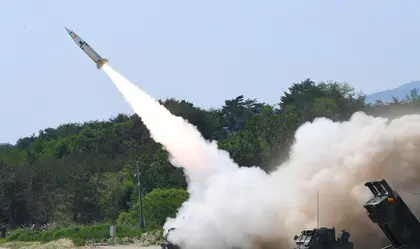Why Ukraine wants them
“Ukraine needs long-range missiles,” President Zelenskyy said in a January video address, “to deprive the occupier of the opportunity to place its missile launchers somewhere far from the front line and destroy Ukrainian cities.”
JOIN US ON TELEGRAM
Follow our coverage of the war on the @Kyivpost_official.
The President and other Ukrainian government representatives have taken every opportunity since then to press the case. They believe that the 300-kilometer range of the ATACMS is essential for destroying Russian command posts, logistics areas and reserve formations in rear areas – which is exactly why the weapon was designed, to meet the exact same requirement of the US Army.
- Access the newest Ukraine news items published today.
- See the most recently published Ukraine news reports from today.
Zelensky raised the issue once again at a July 7 news conference in Prague: “Without long-range weapons, it is difficult not only to carry out an offensive mission but also to conduct a defensive operation.”
ATACMS would allow Ukrainian forces to target all enemy positions in the Russian occupied territories including airfields, supply routes, storage sites, and facilities in Crimea. This would include the 19-kilometer-long Kerch bridge, which has not only strategic value as the peninsula’s only direct supply route from mainland Russia but its symbolic value as one of Putin’s pet projects.
On July 20, Andriy Yermak, Zelensky’s chief of staff, said that ATACMS where at the top of Ukraine’s wish list for weapons. “At this point, it’s very clear and understandable,” he said. “We need and are waiting for decisions on ATACMS.”

Russia Hits Ukraine ‘in Response’ to ATACMS Strike on Taganrog
The other advantage ATACMS would provide, other than its range, is the fact that it is ground launched. While Ukraine already has the Anglo-French Storm Shadow/SCALP cruise missiles in its inventory, with a range of 250 kilometers, these have to be launched from a specially adapted aircraft, of which Ukraine has relatively few.
What exactly is an ATACMS?
ATACMS (pronounced “attack’ems”) is a tactical ballistic missile manufactured by the US defense company Lockheed Martin. Development of the missile started in 1980, based on a US requirement for a long-range, non-nuclear capability to strike enemy rear-area logistic and reserve positions.
It has a solid propellant motor which gives it a range of up to 300 km. The missile is 4 meters high and 610 millimeters in diameter. It can be fired from the tracked M270 Multiple Launch Rocket System (MLRS), and the M142 High Mobility Artillery Rocket System (HIMARS), both of which are in use with the Armed Forces of Ukrainian (AFU).

Test-firing M48 ATACMS/Photo: Lockheed Martin
Originally intended as both an air and ground launched weapon – the Joint Tactical Missile System (JTACMS). The US Air Force withdrew from the program in 1984 to concentrate on cruise missiles so “Joint” was replaced by “Army” and ATACMS was born.
To date there have been five variants of the missile produced:
· The M39 – inertially guided, carrying 950 M74 anti-personnel and anti‑materiel sub-munitions with a range of 25-165 kilometers. Production ceased in 1997; total produced: 1,650;
· The M39A1 – GPS-aided guidance added, size of motor increased resulting in reduced payload of 300 M74 APAM sub-munitions but maximum range increased to 300 kilometers. Production ceased in 2003; total produced: 610;
· The M48 – GPS-aided guidance fit with 230-kilogram WAU-23/B penetrating high-explosive blast fragmentation warhead (same as US Navy Harpoon anti-ship missile), maximum range 300 kilometers. Production 2001-2004; total produced: 176;
· The M57 – improved version of M48 with greater accuracy: Circular Error Probability (CEP) of 9 meters. Production 2004-2013, total produced 513;
· The M57E1 – upgraded M39 and M39A1 with improved motor, updated navigation and guidance software and hardware, and a WAU-23/B warhead section instead of the M74 APAM sub-munitions with proximity sensor for airburst detonation. Production commenced 2017 with total assessed quantity produced 1,200.
The ATACMS replacement
Work began on an ATACMS replacement in 2016, which became the Precision Strike Missile (PrSM) program in 2019, with a planned in-service date of 2023. PrSM, as currently envisaged will be fired from the same M270 MLRS and M142 HIMARS launchers with a range in excess of 500 kilometers.
It is understood that the UK and Australia are involved in the development program with upgrades to its target acquisition capabilities already being worked on.
Why won’t the US give them?
In February both official and unofficial US statements said unequivocally that they would not be providing ATACMS to Ukraine. It was assumed this was because of fears that Ukraine could use the enhanced capability to attack targets on Russian territory. Even though Kyiv gave assurances they wouldn’t and have held true to their word with Storm Shadow.
The next line of refusal was the assertion that Washington believed Ukraine had more pressing needs to improve the effectiveness of its counteroffensive, which was the main driver for the provision of 155mm artillery DPICM (dual-purpose improved conventional munition) cluster munition rounds earlier this month.
The other issue is the number of ATACMS that the US currently holds. While Lockheed Martin figures indicate that around 4,000 missiles have been produced in total with current production at less than 500 missiles per year and the majority of their production earmarked for export. Around 1,750 ATACMS have been sold or are in the process of being delivered to 13 nations. Around 600 were fired by US forces in combat during the Persian Gulf War and the Iraq War.
The Pentagon’s declared 2023 budget included a large-scale purchase of a wide range of ammunition, much of it to replace ammunition provided to Ukraine. Included in the list, which is a multi-year purchase, are 1,700 ATACMS, 700 M142 HIMARS launchers and more than 100,000 GMLRS precision missiles for HIMARS.
These will, the US hopes, cover the gap before the new PrSM munition makes its appearance, though probably delayed, in the US armory. Until that happens, they can’t afford to give any up.
Many commentators and the Ukrainian government hoped that the US position would change, as it had done for by other US weapons systems that were first denied but ultimately approved.
This hope was reinforced by recent events. In late May, Biden appeared to alter his position, saying ATACMS were “still in play.” On June 17 a defense budget bill was tabled in the US Congress for the allocation of $80 million to buy ATACMS for Ukraine and on June 21 the US House Foreign Affairs Committee passed a resolution calling for the Biden administration to supply Ukraine with long-range missiles. President Zelensky said that he and Biden had discussed the missiles at the NATO summit in Vilnius on July 12, although no decision was made.
It remains to be seen if Ukraine’s desire for this weapon will be met.
You can also highlight the text and press Ctrl + Enter






